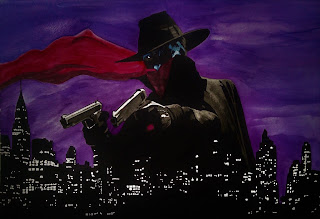LEGENDARY HEROES #22
MANDRAKE THE MAGICIAN
Some regard Mandrake the Magician to be the first comic strip "superhero". Mandrake was created by Lee Falk (1911-1999) who was born Leon Harrison Gross in St. Louis. His father died when he was a young boy and his mother remarried a man named Albert Falk Epstein. After leaving college he adopted the name Lee Falk. Falk was a cartoonist, writer for the pulps, theater director, and producer. He had a fascination for stage magicians ever since he was a boy, and through this he developed the idea of Mandrake. He sketched the first strips himself and was asked years later why Mandrake resembled himself, to which Falk replied, "Well, of course...I was alone in a room with a mirror when I drew him". When Falk went to New York City to pitch the idea of his strip to King Features it was the furthest he had ever travelled from St. Louis. King Features liked the idea and Falk teamed with cartoonist Phil Davis to do the strip which premiered on June 11, 1934 in newspapers across the country. Lee wrote the stories and Phil drew the strips until 1964 when Phil Davis died. Falk hired Fred Fredericks to draw the strip and when Falk passed away in 1999 Fredericks took over the writing of the strip. At the height of it's popularity Mandrake was reaching over 100 million readers every day. The Sunday page was dropped by the syndicate on December 29, 2002. The daily strip ended on July 6, 2013 rather abruptly when Fredericks decided to retire...in mid-story!
Next to his comics (Lee Falk also created The Phantom) Falk's passion was the theater. Over the course of his lifetime he managed five different stage theaters, producing 300 plays, directing 100 of them, and writing a dozen plays. Some of the notable actors and actresses to appear in his productions were Eve Arden, Marlon Brando, Farley Granger, Charlton Heston, Celeste Holm, Chico Marx, James Mason, Paul Newman, Basil Rathbone, Eva Marie Saint, Alexis Smith, and Shelley Winters. In 1953 Brando turned down a movie offer that would have paid him $10,000 a week in order to appear in Falk's production of "Arms and the Man" in Boston for less than $500 a week.
In the comic strip Mandrake is a stage magician who possesses the power to instantly hypnotize people by "gesturing hypnotically". Subjects would see illusions and Mandrake used this ability against gangsters, mad scientists, and space aliens. Over the years Mandrake also developed the power of invisibility, shapeshifting, levitation, and teleportation. Mandrake lived in a mansion named Xanadu atop a mountain in New York state. Assisting him was Lothar, a terrifically strong African that Mandrake met upon his travels. At the time of their meeting Lothar was the Prince of the Seven Nations, a mighty federation of jungle tribes. Also assisting them was Princess Narda from a European country who, despite their infatuation from the start, would not marry Mandrake until 1997 after a 63 year courtship. Mandrake would appear in four different Big Little Books beginning in 1935. The strip would be reprinted in David McKay's Magic Comics from 1939-1949, and Mandrake's image was incorporated into the magazines' logo. Dell Comics also featured Mandrake in their Four Color comic book line. In 1966 King Comics printed 10 issues of Mandrake the Magician.
Mandrake the Magician began a radio series on the Mutual Broadcasting System on November 11, 1940. The shows aired three times a week and were only 15 minutes long but in 1941 the show was expanded to five days a week. Mandrake would utter the incantation "invovo legem magicarum" which stood for "I invoke the laws of magic" and villains were subjected to his powers. Raymond Johnson was Mandrake, Juano Hernandez was Lothar, and Jessica Tandy appeared as Princess Narda. The radio drama ended on February 6, 1942. In 1939 Columbia studios released a 12-chapter serial with Warren Hull as Mandrake. An unauthorized movie was made in Turkey in 1967. In the 1960s Federico Fellini, a close friend of Falk, planned on making a Mandrake movie but the project was never realized. In the early 1980s Embassy Pictures was going to make a Mandrake film and hired Michael Almereyda to write the script. He flew to NYC and checked into the Chelsea Hotel to write the story without distractions, emerging three weeks later to learn that Embassy was under new management and the Mandrake project was dead. NBC did a pilot of Mandrake in 1954 with actual magician Coe Norton appearing as Mandrake and Woody Strode as Lothar, but the show was never picked up for the new season. A 1979 TV-movie was made with Anthony Herrera as the famed magician.
An interesting coincidence involves a real-life magician named Leon Mandrake who had been performing on stages for over ten years before Lee Falk created his comic strip. Like the comic character Leon Mandrake wore a top hat, sported a mustache, and wore a scarlet-lined cape. Falk did not know of the existence of this magician at the time, and it was pure coincidence. However Leon dropped the first name from his act, appearing only as Mandrake, and allowed the public to assume that the popular comic strip was based upon him. In later years Lee Falk would work Leon into the comic strip as a theatrical magician.


.jpg)


Comments
Post a Comment